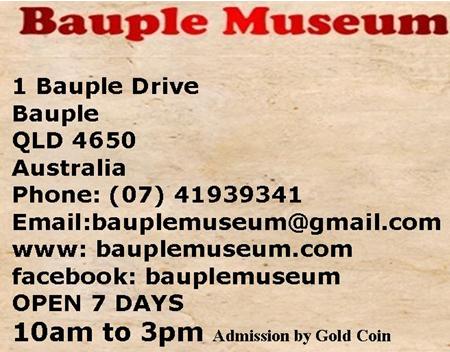

Bauple Museum & District Historical Society Inc.
 |
 Bauple Museum & District Historical Society Inc. |
|
Driving south through the historic town of Tiaro, the horizon at the end of Mayne Street is dominated by a peak of a long mountain range, known - in one way or another - as Bauple mountain.
Bauple Mountain is of great cultural and spiritual significance to the Kabi Kabi people and the Butchulla people.This ancient and enduring connection is something I would like to write about in the future but is beyond the scope of the short space I have here, where I will focus on more narrow aspects of the geographical feature's history. The spelling has now settled on Bauple, but has been recorded as Bopple, Boppil, Boopal and Baphal.The different spellings arising from the adaption of an Indigenous word into the Latin alphabet is understandable.
What is something of a mystery though is the actual location of Mount Bauple. Generally, the whole range is known as Bauple Mountain, but each of the peaks have also been named, and following some research by local historian Tony Clift, it seems at some point they have become mixed up on official maps. The famous explorer Ludwig Leichhardt was in this area in late July and early August 1843, staying at the first attempt at European settlement of the region; the head station of John Eales on the eastern side of today's Black Swamp at Tiaro. Ludwig, whose disappearance on his overland expedition across the continent a few years later remains one of the great enduring mysteries in Australian history, climbed the northern-most peak, which he referred to as Mount Boople.He made a few sketches of the area in his diary including one of the range and Mount Boople.On August 2, 1843 Leichhardt climbed to the top of this range that the Bruce Highway now runs beneath. That evening he recorded some of his thoughts:" This morning I went to Mt Boople, which rises about 1000-1200' towards the south." The stream that comes down from it, rolling along the rock of the mountain to the valley, is surrounded on both sides by dense scrub that spreads towards the upper middle of the mountain and completely covers the northernmost summit." Low ranges of hills lie before the mountain or mountain range, because it consists of several summits. ”From different historical reports, it seems clear that the northernmost peak, the one that is unmissable when driving south along Mayne Street, was known as Mount Bopple (or other similar spellings) during the 19th century. The 1906 map of the range by government geologist Benjamin Dunstan confirms this peak as Mount Bopple, by which time there were a number of graphite mines on its slopes. Interestingly, this map shows the range's highest peak, toward the middle, as Beacon Peak, presumably after a beacon placed there in the late 19th century. Further south, the other peak was named Mount Gundiah. There seems to be no doubt that for many decades the northern peak was known locally and officially as Mount Bopple. However, a current topographical map identifies Mount Bauple as the peak previously known as Beacon Peak and just to the south of it a lower one is named Mount Guyra, while the previously named Mount Bopple and Mount Gundiah are unnamed. So what has happened here? When and why did the name change happen? Tony has come up with a possible explanation. During World War II, when the country was in danger of an advancing Japanese force there was an urgent need for accurate topographical mapping for defence purposes. In aid of this, a Royal Australian Service Corps team summited Beacon Peak, whereupon they found a derelict earlier installation from which the peak derived its name. They then marked the site with their own reference marks and identified the peak on their map as Bauple. During the urgency of war, presumably no one questioned the change of name. Following the war, their map was referred to and so it has remained on later maps. The mystery of the misnaming is certainly not as intriguing as the disappearance of Leichhardt, but it is one the many quirks that enliven local history. Maybe the original, now officially unnamed peak, could be called Mount Leichhardt in recognition of his early local visit.
|
 |
|
|
|
Home | The Museum | Gallery | Facilities | Highlights | Membership | Contact Us |
||
|
Copyright Honeypass Ltd 2010 - 2012 |
||